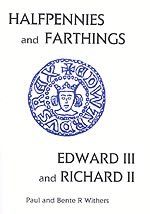An interesting reign to collect - as there are a number of quite distinct types. While the weight of the coins remained unchanged from those of Edward II, the purity/fineness was reduced.
Coins of this reign were minted in four places, which can easily be identified by the legend on the reverse of each coin:
To find out more about the farthing types for each mint, click on the mint name above.
Click here to find out more about why the coinage of Edward III has classifications such as Pre-Treaty, Treaty and Post-Treaty.
¹ WALKER. AS. 1921: 'The Calais Mint, AD 1347-1470' BNJ 16, p. 77-112.






![Validate my RSS feed [Valid RSS]](../valid-rss.png)